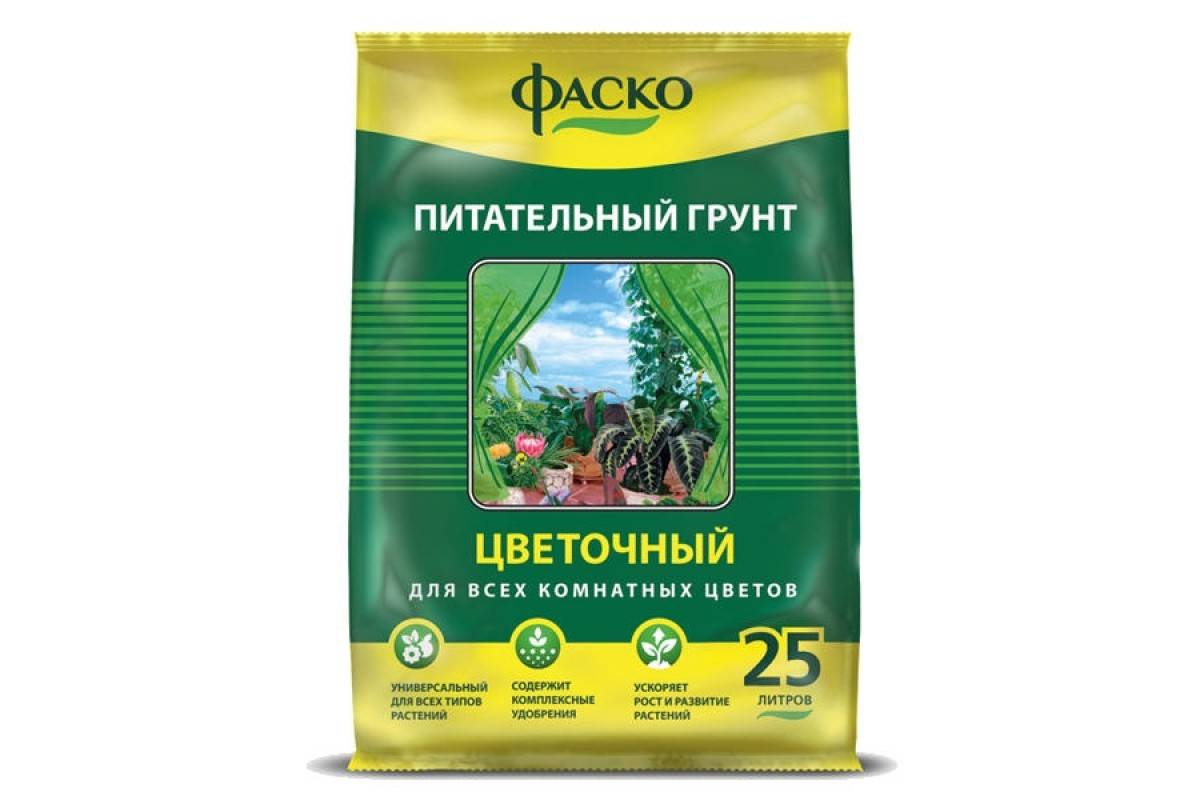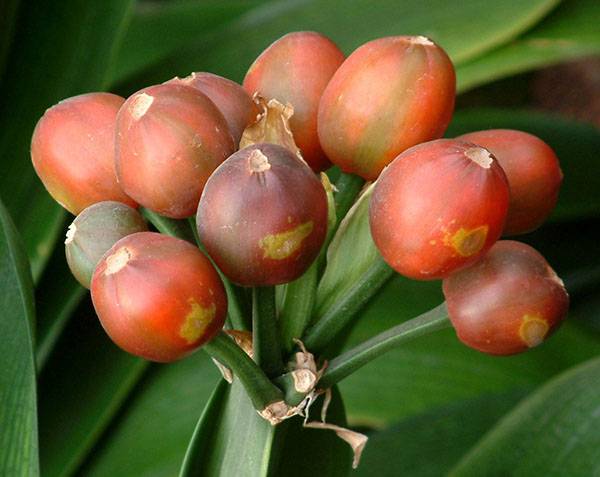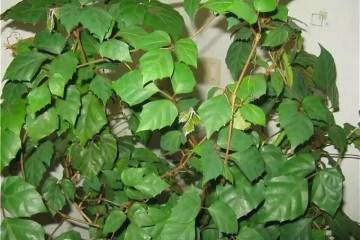Clivia - home care
Content:
Clivia is an ornamental plant that can bloom at the end of winter and delight everyone with exotic flowers. For stable growth and development, the most important thing that clivia requires is home care.
Clivia - what is this noble flower
Clivia is a perennial plant belonging to the Amaryllidaceae family. It has long, large and fleshy leaves, collected in a rosette. The plant lacks a full-fledged stem. The leaf plates have a dark green glossy finish. They can bend easily. The length of one leaf is 40-75 cm, the width usually does not exceed 5-8 cm. The clivia plant can reach 40-60 cm in height.
The inflorescences consist of many opened buds, the maximum number of which can be 30 pcs. Outwardly, the flowers of the plant resemble a bell. Each flower has 6 petals. Their color can be red, orange, yellow, white or pink. Each of them contains long stamens and an ovary. The aroma of the plant combines the scents of vanilla, nutmeg, rose and grass. During fruiting, a large berry is formed.
In the wild, it is most often found in the subtropics of South Africa. It can be planted at home and in greenhouses in countries where temperate climates prevail. Under such conditions, the rate of flower development is average. Up to 6 leaves appear on the plant per year. Under favorable conditions of existence, the maximum life span of a flower is 40 years.
It is believed that clivia is a flower that helps with concentration and brain performance. In this regard, his appearance in the house will have a positive effect on the mental abilities of a person. Also, the flower improves the emotional state of a person, making him kinder and calmer.
Flower varieties
At the moment, there are 23 varieties of this flower. The main types and their distinctive features:
- Clivia cinnabar (Clivia miniata). The bush has a rosette with long sharp leaves of a dark green color. On the leaves there are oblong stripes of white or yellow. The length of the foliage reaches 60 cm. The height of the bush varies between 45-50 cm. During flowering, inflorescences with funnel-shaped red buds are formed. Clivia Miniata is most often grown by flower growers;
- Lemon clivia (Clivia miniata Citrina). The bush bears great resemblance to the cinnabar variety. The main difference is the creamy yellow color of the leaves. The resulting berries also have a yellowish tint;
- Clivia the beautiful, or Nobilis (Clivia nobilis). It is a perennial stemless plant with leaves collected in a rosette that look like a sword. From bell-shaped flowers, umbrella-shaped or racemose inflorescences are formed, 14 pcs. The flowers are orange with a pinkish tint. The height of orange clivia can be 30-50 cm.
Home care for clivia
It is necessary to create the best microclimate for the plant. Insufficient or excessive care can equally damage the flower. You need to look after by following the rules.
Temperature
It is necessary to maintain an optimal temperature regime, which differs depending on the season. In summer, the room temperature should be at least 20-25 ° C. The plant can be taken out on the balcony or on the veranda for ventilation. But before that, you should take care of protection from the sun's rays. From autumn to winter, during the dormant period, the temperature should be 12-15 ° C. During the flowering period, which begins in late winter or early spring, the best temperature is 20-25 ° C.
Illumination
The flower should be provided with bright lighting. The best place to place the plant is on the western or eastern windowsill. It is not recommended to choose the northern windowsill, because the bush will suffer from a lack of lighting: growth will stop, and flowering will not occur. It is recommended to lower the light level at noon or after landing and transplanting. Lighting should be diffused.
Humidity
Clivia has developed a good tolerance to dry indoor air. During cultivation in the room, the air humidity can vary between 40 - 50%. The leaves of the plant are periodically sprayed and wiped with a damp cloth. Wet expanded clay can be placed on the pallet. In this case, it is worth making sure that the roots of the flower do not get wet. Otherwise, they will rot.
Watering
Watering frequency varies with the season. In the summer season, watering the plant is necessary every time the top layer of the earth becomes dry. Usually this procedure is performed once every 7 days. When the flower is preparing for the upcoming flowering, that is, during the dormant period, the frequency of watering is reduced. This procedure will need to be carried out only after the tips of the leaves have dried a little. After the onset of bud formation, watering begins more often as the surface of the earth dries up.
You cannot water the clivia with plain water from the mains. She's too hard. It needs to be heated to room temperature by boiling.
Top dressing
It should be in solid or liquid form with a low nitrogen content. The bush is fed 1-2 times within 7 days during the period of active growth and development. The procedure for introducing nutrients should continue from early March to late August. Solid fertilizers are applied before watering. The plant is watered with liquid fertilizers, after which it is washed with clean boiled water. For the bush, liquid universal fertilizer for flowers from any garden store is suitable. Successful cultivation will be facilitated by the alternation of organic and mineral fertilizers.
It is important to make sure that the nitrogen in the flower is not contained in large quantities. It should not exceed the level of phosphorus and potassium. The dark shade of the leaves and the lack of blooming are signs of a high concentration of nitrogen compounds. During the dormant period, feeding is stopped in order to avoid disrupting the further process of growth and flowering.
Pruning
This is an important procedure for flowering and reproduction of clivia. Peduncles that appear in February and grow for 2 months should be pruned.
The soil
Clivia is suitable for a versatile loose substrate or soil intended for decorative deciduous plants. Typically, this soil consists of the following nutrients:
- charcoal;
- coconut substrate;
- sphagnum;
- humus and perlite.
The soil for clivia should be slightly acidic and light. You can not buy it, but mix it yourself by adding woody soil, sand and peat soil.
Transfer
It is recommended to replant the young bush annually in the spring after flowering. Older plants do not need to be repotted as often. It is definitely worth replanting the bush if the growing roots are visible from the drainage holes.
Transplanting clivia at home requires a suitable pot. It should be wider and larger than the previous one in terms of volume. In this case, a pot that is too spacious should not be taken. A tight fit is best. This will rid the plant of excess moisture damaging parts of the flower and speed up the flowering process.
Before the transplant, it is necessary to carry out preparatory work. The bottom of the pot should be filled with a drainage layer (3 cm) of expanded clay granules, small pebbles or gravel. This will allow you to regulate the moisture content of the soil. It will not be superfluous to disinfect the soil, since there is a possibility of the presence of dangerous bacteria and parasite larvae that provoke diseases in the plant. There are 4 ways to disinfect soil:
- spilling the soil with boiling water;
- processing the earth with a solution of potassium permanganate;
- warming up the soil in an oven preheated to 250 ° C for 10 minutes;
- calcining the soil in a microwave oven for 3 min. at maximum temperature.
Step-by-step instructions on how to transplant a flower:
- Gently remove the clivia from the old pot, shake off the roots and put it in the water.
- Pour half of the prepared earth into a new container.
- Place the flower, gently deepening and straightening the roots.
- Pour the remaining soil on top, without completely covering the flower.
- Tamp the topsoil.
How often does clivia bloom?
The bush usually begins to bloom at the end of winter. You can observe flowering in a large specimen 2 times a year. After the end of the dormant period, a peduncle 15-17 cm long appears. The flower is moved to the warmest place. If the peduncle does not grow in length, it is required to awaken the plant. Watering with water heated to 40 ° C will help in this.
On the peduncle, yellowish, red or pink flowers bloom alternately, and not simultaneously. Because of this, the whole process can take a long time, about 1 month. Re-flowering can be seen in the middle of summer.
Reproduction of clivia
Many are interested in how clivia reproduces. For reproduction of the South African beauty, 2 methods are used - seed and vegetative. In the first case, you will have to spend more time than in the second. The way how to propagate by seeds:
- During the flowering period, cross-pollinate to form berries with seeds.
- Wait 11 months for the fruit to redden.
- Extract seeds from them and sow into the ground without deepening.
- Pour a little and cover with foil, transferring to a warm place. Sometimes it is recommended to remove the film for airing and watering the seeds.
- After 1.5 months, seedlings will be seen. Place them in separate containers when 2-3 leaves are formed. The first flowering will occur in 3 years.
Simple growers prefer the vegetative method more, because it is much faster. The scheme for performing vegetative reproduction:
- Separate the babies (shoots) from the plant when the pot becomes cramped. From the mother bush, it is necessary to take shoots with 4-5 leaves.
- Distribute them in containers filled with perlite or sand with earth.
- Water each instance a little. After 2 years, young plants will bloom.
If you do not remove the grown children, then after some time you can get a large number of peduncles in one container. Thus, additional decorativeness is acquired from the flower.
Diseases and pests
The flower can get sick due to improper care or planting, or be damaged by harmful insects. The most common diseases, pests and methods of dealing with them:
- gray rot. This fungal disease occurs due to over-watering. The root system begins to rot, the leaves become covered with brown spots, and may turn yellow. Here, pruning of damaged parts of the bush and transplanting into new soil will help;
- falling foliage. The reason is the lack of water and nutrients. The regulation of fertilizing and watering during the dormant period will correct the situation;
- shield. This insect is covered with a wax shield. Their larvae actively move along the leaves, and the larger ones stick and freeze in place. They arise from a lack of moisture and light. You can get rid of them with a solution of laundry soap. You will also need to provide good lighting and watering.
If you initially take a responsible approach to growing a plant, then there will be no problems. For a clivia flower, home care must be correct, otherwise it will never shoot an arrow.




















